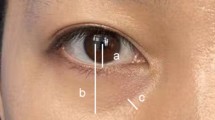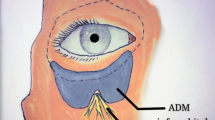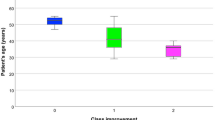Abstract
Objective
To evaluate the effectiveness and safety of autologous fibroblasts combined with keratin gel for tear trough deformity rectification as injectable soft tissue filler.
Materials and Methods
The new injectable soft tissue filler was derived from autologous fibroblasts and keratin gel. A total of 35 patients received treatment of this filler injection for tear trough deformity rectification. All the patients were followed up, and the clinical features including photographs and satisfaction were collected and assessed at 1, 3, 6, 12 and 24 months after injection. The efficacy of each patient was evaluated independently by blinded evaluators at different time points. All patients consented to publish identifiable photographs in this study.
Results
Tear trough deformity was improved even at 18–24 months post-injection. No severe adverse effects were observed resulting from the filler injection.
Conclusion
Combination of autologous fibroblasts and keratin is efficient and safe for correction of the tear trough deformity with long-term satisfaction and desirable result.
Level of Evidence IV
This journal requires that authors assign a level of evidence to each article. For a full description of these Evidence-Based Medicine ratings, please refer to the Table of Contents or the online Instructions to Authors www.springer.com/00266.






Similar content being viewed by others
References
Loeb R (1981) Fat pad sliding and fat grafting for leveling lid depressions. Clin Plast Surg 8:757–776
Flowers RS (1993) Tear trough implants for correction of tear trough deformity. Clin Plast Surg 20:403–415
Hirmand H (2010) Anatomy and nonsurgical correction of the tear trough deformity. Plast Reconstr Surg 125:699–708
De Pasquale A, Russa G, Pulvirenti M, Di Rosa L (2013) Hyaluronic acid filler injections for tear-trough deformity: injection technique and high-frequency ultrasound follow-up evaluation. Aesthet Plast Surg 37:587–591
Wong CH, Mendelson B (2017) Extended transconjunctival lower eyelid blepharoplasty with release of the tear trough ligament and fat redistribution. Plast Reconstr Surg 140:273–282
Chiu CY, Shen YC, Zhao QF (2017) Treatment of tear trough deformity: fat repositioning versus autologous fat grafting. Aesthet Plast Surg 41:73–80
Boss WK Jr, Usal H, Fodor PB, Chernoff G (2000) Autologous cultured fibroblasts: a protein repair system. Ann Plast Surg 44:536–542
Schmidt CFDA (2011) approves first cell therapy for wrinkle-free visage. Nat Biotechnol 29:674–675
Yoon E-S, Han S-K, Kim W-K (2003) Advantages of the presence of living dermal fibroblasts within restylane for soft tissue augmentation. Ann Plast Surg 51:587–592
Weiss R, Weiss M, Beasley K et al (2005) Autologous cultured living fibroblast injection for facial contour deformities: a prospective, placebo-controlled, phase III clinical trial. Retour Au Numéro 52(3):P206
Wang S, Taraballi F, Tan LP, Ng KW (2012) Human keratin hydrogels support fibroblast attachment and proliferation in vitro. Cell Tissue Res 347:795–802
Ma J, Zhang J, Ma XJ et al (2011) Evaluation of biocompatibility and biodegradability of a new auto-derived injectable soft tissue filler: a preliminary report. Eur J Plast Surg 34:479–486
Wang Y, Wang B, Zhang Q, Ma J (2017) New soft tissue filler derived from autologous keratin and fibroblast for neck wrinkles. J Cosmet Dermatol 17:1–6
Moon KC, Lee HS, Han SK, Chung HY (2017) Correcting nasojugal groove with autologous cultured fibroblast injection: a pilot study. Aesthet Plast Surg 42:1431–5241
Tachibana A, Furuta Y, Takeshima H, Tanabe T, Yamauchi K (2002) Fabrication of wool keratin sponge scaffolds for long-term cell cultivation. J Biotechnol 93:165–170
Sierpinski P, Garrett J, Ma J, Apel P, Klorig D, Smith T, Koman LA, Atala A, Van Dyke M (2008) The use of keratin biomaterials derived from human hair for the promotion of rapid regeneration of peripheral nerves. Biomaterials 29:118–128
Apel PJ, Garrett JP, Sierpinski P, Ma J, Atala A, Smith TL, Koman LA, Van Dyke ME (2008) Peripheral nerve regeneration using a keratin-based scaffold: long-term functional and histological outcomes in a mouse model. J Hand Surg Am 33:1541–1547
Aboushwareb T, Eberli D, Ward C, Broda C, Holcomb J, Atala A, Van Dyke M (2009) A Keratin biomaterial gel hemostat derived from human hair: evaluation in a rabbit model of lethal liver injury. J Biomed Mater Res B 90:45–54
Zhou FL (2007) Experimental study of autologous fibroblast and hair keratin as soft tissue in nude mice. Southeast University, Nanjing
Tang DJ, Zhang J, Li DB et al (2008) Experimental study of human keratin as tissue fill in Mini pig. Chin J Aesthet Plast Surg 19(2):144–146
Funding
The article was sponsored by National Natural Science Foundation of China (Nos. 81571924, 31671312).
Author information
Authors and Affiliations
Contributions
WX, CZ and JZ participated in the clinical application of the technique and the follow-up of the patients and analysis of data for the work. All authors participated drafted the article. QZ contributed the conception and design of the study and revised it critically for important intellectual content. All the authors approved the version to be submitted.
Corresponding authors
Ethics declarations
Conflict of interest
The authors report no financial and personal relationships with other people or organizations that could inappropriately influence the work.
Rights and permissions
About this article
Cite this article
Xing, W., Zhang, C., Zhang, J. et al. Correction of Tear Trough Deformity Using Autologous Fibroblast Combined with Keratin: New Soft Tissue Filler. Aesth Plast Surg 43, 221–227 (2019). https://doi.org/10.1007/s00266-018-1259-y
Received:
Accepted:
Published:
Issue Date:
DOI: https://doi.org/10.1007/s00266-018-1259-y




